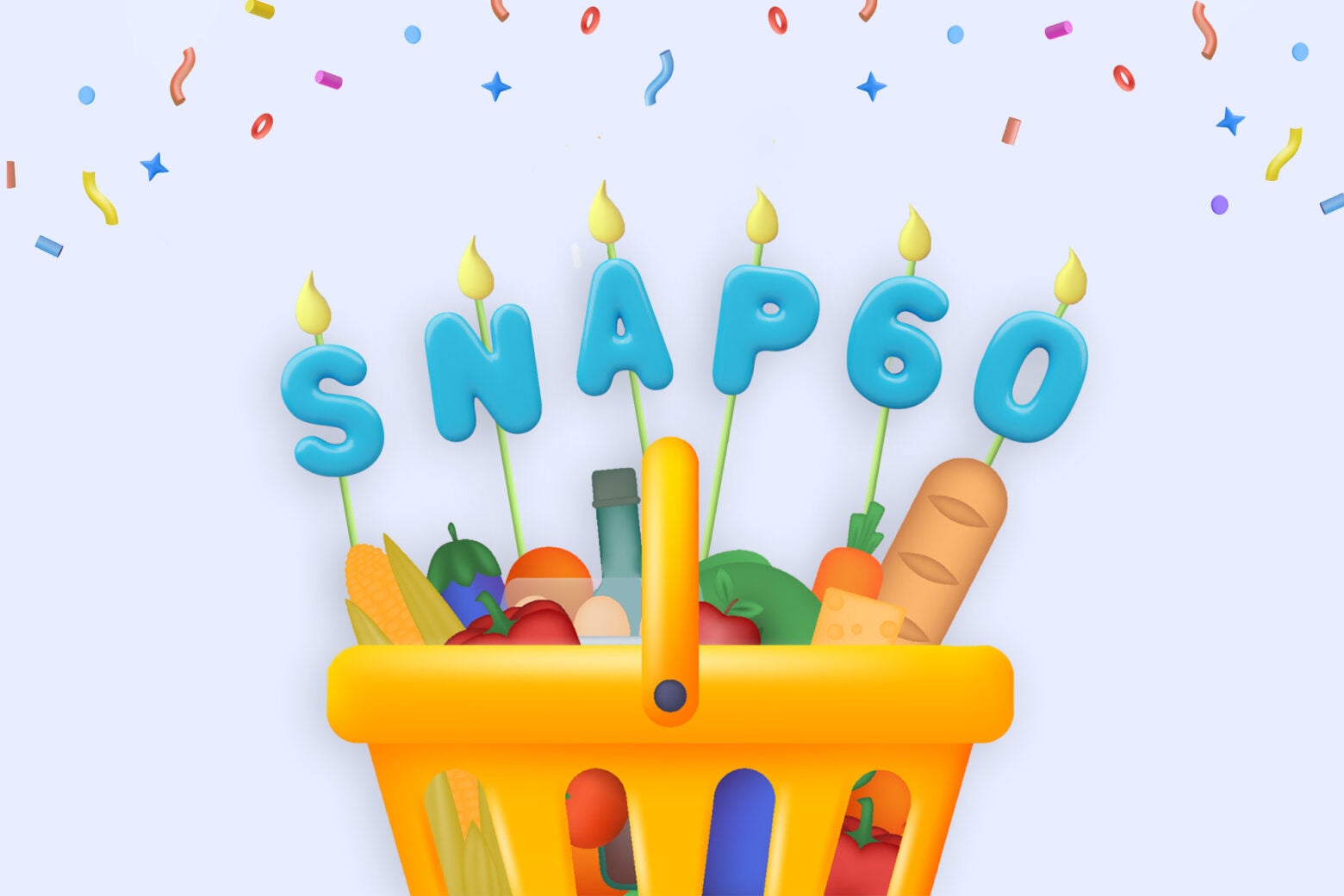
Opinion
As food stamps turn 60, four reasons to celebrate
Quick, name one of America’s most successful social welfare programs. (Vote in our poll.) You probably didn’t come up with food stamps—the program about to observe its 60th birthday.
That’s a shame. I’ve spent years researching the history, political resilience, and impact of what is now the Supplemental Nutrition Assistance Program, or SNAP. In an era of cynicism about government, SNAP stands out for doing its job. Yet most Americans, even those who benefit from SNAP, are unaware of its scope and importance.
Signed into law on August 31, 1964, the nation’s largest food assistance program now makes a difference in the lives of some 42 million Americans. Here are four reasons why SNAP is worth celebrating as a government program that works.
SNAP feeds many Americans
SNAP does what its name suggests: It supplements food purchasing power, thereby alleviating household food insecurity, reducing poverty, and improving health. Any household with gross income below 130 percent of the federal poverty line—such as a family of four earning less than $47,554—is eligible. It is flexible—benefit levels are adjusted for household income and size, and it permits income deductions for basic needs, such as rent and a car. And SNAP tides people over when they have short-term swings in household income, as it did during the COVID-19 pandemic. SNAP beneficiaries include active military service members with families, seasonal workers, and college students—anyone whose income does not keep up with routine expenses.
Sign up for Harvard Public Health
Delivered to your inbox weekly.
SNAP offers dignity and choice
SNAP’s roots are in a Depression-era program that enabled enrollees to “purchase” food at local retailers with postage-stamp-sized coupons—hence “food stamps.” Paper was phased out in the early 2000s in favor of the Electronic Benefit Transfer (EBT) card, onto which a specific dollar amount in benefits is loaded each month. The EBT card is one of SNAP’s superpowers. Program enrollees go to one of approximately 250,000 participating food retailers, from Walmart to the local bodega, select their groceries, and use the EBT card to pay. That’s it. No colored coupons that shame the user at checkout. No box of food picked out by someone else. With the EBT card, the SNAP user is a consumer, like any other American.
SNAP has broad support
The key puzzle in my research was how SNAP has endured over six decades despite efforts by some conservatives to cut back or eliminate the program. The answer: it’s about food. Even as the parties spar over SNAP rules, the program overall enjoys wide public support. Americans may not like “welfare” in the abstract, but they also don’t want fellow Americans to go hungry. SNAP’s focus on food is key to its longevity.
SNAP is politically viable
While expanded cash assistance has similar anti-poverty effects, the failure to extend pandemic-era supplements suggests that SNAP’s “in kind” arrangement poses fewer political problems. Political feasibility matters.
In the $112.8 billion program, fraud by SNAP recipients is rare. Yes, an occasional SNAP user sells an EBT card at a discount for cash, but fraud rates are a little over one percent of benefits provided. A bigger problem is theft of benefits through card skimmers at checkout, accounting for millions of dollars of losses to enrollees who can ill afford them. Another occurs when states miscalculate benefits.
Could SNAP be better? Sure. Two suggestions:
Make it easier to apply for food stamps
SNAP benefits are funded by the federal government, but the program is administered through the states. Some states make applying as easy as possible, while others demand excessive household details or require in-person interviews, among other administrative burdens. Where you live in America should not determine whether you can access benefits to which you are entitled.
Loosen purchase restrictions on food stamps
Urban legends notwithstanding, you cannot use SNAP to buy cigarettes and booze. But you also cannot use it for diapers or soap, or even hot prepared foods. The program still reflects 1960s-era assumptions that mom is at home cooking from scratch, not rushing from work to cobble dinner together. That $4.99 Costco rotisserie chicken is a lifesaver for working parents. Congress must update SNAP to the realities of life in 2024.
SNAP works. Without it, tens of millions of Americans would be far worse off. Short of addressing poverty—the root cause of food insecurity—SNAP ensures that all Americans get a chance at a decent diet without sacrificing all personal autonomy and pride. That’s no small achievement.
Sources images: iStock
Republish this article
<p>The program reduces food insecurity and poverty.</p>
<p>Written by Christopher Bosso</p>
<p>This <a rel="canonical" href="https://harvardpublichealth.org/policy-practice/food-stamps-are-turning-60-heres-why-we-should-celebrate/">article</a> originally appeared in<a href="https://harvardpublichealth.org/">Harvard Public Health magazine</a>. Subscribe to their <a href="https://harvardpublichealth.org/subscribe/">newsletter</a>.</p>
<p class="has-drop-cap is-style-default">Quick, name one of America’s most successful social welfare programs. (<a href="https://harvard.az1.qualtrics.com/jfe/form/SV_82KPXMhm3w0wnSS" target="_blank" rel="noreferrer noopener">Vote in our poll</a>.) You probably didn’t come up with food stamps—the program about to observe its 60th birthday.</p>
<p class="is-style-default">That’s a shame. I’ve spent years researching the <a href="https://www.ucpress.edu/book/9780520392816/why-snap-works" target="_blank" rel="noreferrer noopener">history</a>, political resilience, and impact of what is now the Supplemental Nutrition Assistance Program, or SNAP. In an era of cynicism about government, SNAP stands out for <a href="https://harvardpublichealth.org/policy-practice/food-stamps-feed-americans-but-can-they-help-them-eat-better/" target="_blank" rel="noreferrer noopener">doing its job</a>. Yet most Americans, even those who benefit from SNAP, are unaware of its scope and importance.</p>
<p><a href="https://www.usda.gov/media/blog/2014/10/15/commemorating-history-snap-looking-back-food-stamp-act-1964">Signed into la</a><a href="https://www.usda.gov/media/blog/2014/10/15/commemorating-history-snap-looking-back-food-stamp-act-1964" target="_blank" rel="noreferrer noopener">w</a> on August 31, 1964, the nation’s largest food assistance program now makes a difference in the lives of some <a href="https://fns-prod.azureedge.us/sites/default/files/resource-files/snap-annualsummary-5.pdf" target="_blank" rel="noreferrer noopener">42 million Americans</a>. Here are four reasons why SNAP is worth celebrating as a government program that works.</p>
<h2 class="wp-block-heading" id="h-snap-feeds-many-americans">SNAP feeds many Americans</h2>
<p>SNAP does what its name suggests: It supplements food purchasing power, thereby <a href="https://www.ers.usda.gov/publications/pub-details/?pubid=84335" target="_blank" rel="noreferrer noopener">alleviating household food insecurity</a>, <a href="https://www.ers.usda.gov/webdocs/publications/44963/17742_err132_1_.pdf" target="_blank" rel="noreferrer noopener">reducing poverty</a>, and <a href="https://www.cbpp.org/research/food-assistance/snap-is-linked-with-improved-health-outcomes-and-lower-health-care-costs" target="_blank" rel="noreferrer noopener">improving health</a>. Any household with gross income below 130 percent of the <a href="https://aspe.hhs.gov/topics/poverty-economic-mobility/poverty-guidelines" target="_blank" rel="noreferrer noopener">federal poverty</a> line—such as a family of four earning less than $47,554—is eligible. It is flexible—benefit levels are adjusted for household income and size, and it permits income deductions for basic needs, such as rent and a car. And SNAP tides people over when they have short-term swings in household income, as it did during the COVID-19 pandemic. SNAP beneficiaries include <a href="https://www.cbpp.org/research/food-assistance/snap-helps-almost-14-million-low-income-veterans-including-thousands-in" target="_blank" rel="noreferrer noopener">active military</a> service members with families, seasonal workers, and college students—anyone whose income does not keep up with routine expenses.</p>
<h2 class="wp-block-heading" id="h-snap-offers-dignity-and-choice">SNAP offers dignity and choice</h2>
<p>SNAP’s roots are in a Depression-era program that enabled enrollees to “purchase” food at local retailers with postage-stamp-sized coupons—hence “food stamps.” Paper was phased out in the early 2000s in favor of the Electronic Benefit Transfer (EBT) card, onto which a specific dollar amount in benefits is loaded each month. The EBT card is one of SNAP’s superpowers. Program enrollees go to one of approximately 250,000 participating food retailers, from Walmart to the local bodega, select their groceries, and use the EBT card to pay. That’s it. No colored coupons that shame the user at checkout. No box of food picked out by someone else. With the EBT card, the SNAP user is a consumer, like any other American.</p>
<h2 class="wp-block-heading" id="h-snap-has-broad-support">SNAP has broad support</h2>
<p>The key puzzle in my research was how SNAP has endured over six decades despite efforts by some conservatives to cut back or eliminate the program. The answer: it’s about <em>food</em>. Even as the parties spar over SNAP rules, the program overall <a href="https://today.yougov.com/topics/politics/articles-reports/2023/02/08/americans-evaluate-social-security-medicare-poll" target="_blank" rel="noreferrer noopener">enjoys wide public support</a>. Americans may not like “welfare” in the abstract, but they also don’t want fellow Americans to go hungry. SNAP’s focus on food is key to its longevity.</p>
<h2 class="wp-block-heading" id="h-snap-is-politically-viable">SNAP is politically viable</h2>
<p>While expanded cash assistance has similar anti-poverty effects, the failure to extend pandemic-era supplements suggests that SNAP’s “in kind” arrangement poses fewer political problems. Political feasibility matters.</p>
<p>In the <a href="https://www.ers.usda.gov/topics/food-nutrition-assistance/supplemental-nutrition-assistance-program-snap/key-statistics-and-research/#:~:text=In%20FY%202023%2C%20SNAP%20served,%24211.93%20per%20participant%20per%20month.&text=Download%20chart%20data%20in%20Excel%20format.,-The%20share%20of" target="_blank" rel="noreferrer noopener">$112.8 billion program</a>, fraud by SNAP recipients is rare. Yes, an occasional SNAP user sells an EBT card at a discount for cash, but <a href="https://www.fns.usda.gov/pressrelease/2013/fns-001213" target="_blank" rel="noreferrer noopener">fraud</a> rates are a little over one percent of benefits provided. A bigger problem is theft of benefits through <a href="https://www.salon.com/2024/06/08/recipients-of-snap-benefits-are-falling-victim-to-rampant-ebt-card-skimming-schemes/" target="_blank" rel="noreferrer noopener">card skimmers</a> at checkout, accounting for millions of dollars of losses to enrollees who can ill afford them. Another occurs when <a href="https://fns-prod.azureedge.us/sites/default/files/resource-files/snap-fy22-qc-payment-error-rate.pdf" target="_blank" rel="noreferrer noopener">states miscalculate benefits</a>.</p>
<p>Could SNAP be better? Sure. Two suggestions:</p>
<h2 class="wp-block-heading" id="h-make-it-easier-to-apply-for-food-stamps">Make it easier to apply for food stamps</h2>
<p>SNAP benefits are funded by the federal government, but the program is administered through the states. Some states make applying as easy as possible, while others demand excessive household details or require in-person interviews, among other <a href="https://www.americanprogress.org/article/how-to-address-the-administrative-burdens-of-accessing-the-safety-net/" target="_blank" rel="noreferrer noopener">administrative burdens</a>. Where you live in America should not determine whether you can access benefits to which you are entitled.</p>
<h2 class="wp-block-heading" id="h-loosen-purchase-restrictions-on-food-stamps">Loosen purchase restrictions on food stamps</h2>
<p>Urban legends notwithstanding, you cannot use SNAP to buy cigarettes and booze. But you also cannot use it for diapers or soap, or even <a href="https://www.vice.com/en/article/g5qd4b/hot-meals-food-stamps" target="_blank" rel="noreferrer noopener">hot prepared foods</a>. The program still reflects 1960s-era assumptions that mom is at home cooking from scratch, not rushing from work to cobble dinner together. That $4.99 Costco rotisserie chicken is a lifesaver for working parents. Congress must update SNAP to the realities of life in 2024.</p>
<p class=" t-has-endmark t-has-endmark">SNAP works. Without it, tens of millions of Americans would be far worse off. Short of addressing poverty—the root cause of food insecurity—SNAP ensures that all Americans get a chance at a decent diet without sacrificing all personal autonomy and pride. That’s no small achievement.</p>
<script async src="https://www.googletagmanager.com/gtag/js?id=G-S1L5BS4DJN"></script>
<script>
window.dataLayer = window.dataLayer || [];
if (typeof gtag !== "function") {function gtag(){dataLayer.push(arguments);}}
gtag('js', new Date());
gtag('config', 'G-S1L5BS4DJN');
</script>
Republishing guidelines
We’re happy to know you’re interested in republishing one of our stories. Please follow the guidelines below, adapted from other sites, primarily ProPublica’s Steal Our Stories guidelines (we didn’t steal all of its republishing guidelines, but we stole a lot of them). We also borrowed from Undark and KFF Health News.
Timeframe: Most stories and opinion pieces on our site can be republished within 90 days of posting. An article is available for republishing if our “Republish” button appears next to the story. We follow the Creative Commons noncommercial no-derivatives license.
When republishing a Harvard Public Health story, please follow these rules and use the required acknowledgments:
- Do not edit our stories, except to reflect changes in time (for instance, “last week” may replace “yesterday”), make style updates (we use serial commas; you may choose not to), and location (we spell out state names; you may choose not to).
- Include the author’s byline.
- Include text at the top of the story that says, “This article was originally published by Harvard Public Health. You must link the words “Harvard Public Health” to the story’s original/canonical URL.
- You must preserve the links in our stories, including our newsletter sign-up language and link.
- You must use our analytics tag: a single pixel and a snippet of HTML code that allows us to monitor our story’s traffic on your site. If you utilize our “Republish” link, the code will be automatically appended at the end of the article. It occupies minimal space and will be enclosed within a standard <script> tag.
- You must set the canonical link to the original Harvard Public Health URL or otherwise ensure that canonical tags are properly implemented to indicate that HPH is the original source of the content. For more information about canonical metadata, click here.
Packaging: Feel free to use our headline and deck or to craft your own headlines, subheads, and other material.
Art: You may republish editorial cartoons and photographs on stories with the “Republish” button. For illustrations or articles without the “Republish” button, please reach out to republishing@hsph.harvard.edu.
Exceptions: Stories that do not include a Republish button are either exclusive to us or governed by another collaborative agreement. Please reach out directly to the author, photographer, illustrator, or other named contributor for permission to reprint work that does not include our Republish button. Please do the same for stories published more than 90 days previously. If you have any questions, contact us at republishing@hsph.harvard.edu.
Translations: If you would like to translate our story into another language, please contact us first at republishing@hsph.harvard.edu.
Ads: It’s okay to put our stories on pages with ads, but not ads specifically sold against our stories. You can’t state or imply that donations to your organization support Harvard Public Health.
Responsibilities and restrictions: You have no rights to sell, license, syndicate, or otherwise represent yourself as the authorized owner of our material to any third parties. This means that you cannot actively publish or submit our work for syndication to third-party platforms or apps like Apple News or Google News. Harvard Public Health recognizes that publishers cannot fully control when certain third parties aggregate or crawl content from publishers’ own sites.
You may not republish our material wholesale or automatically; you need to select stories to be republished individually.
You may not use our work to populate a website designed to improve rankings on search engines or solely to gain revenue from network-based advertisements.
Any website on which our stories appear must include a prominent and effective way to contact the editorial team at the publication.
Social media: If your publication shares republished stories on social media, we welcome a tag. We are @PublicHealthMag on X, Threads, and Instagram, and Harvard Public Health magazine on Facebook and LinkedIn.
Questions: If you have other questions, email us at republishing@hsph.harvard.edu.


